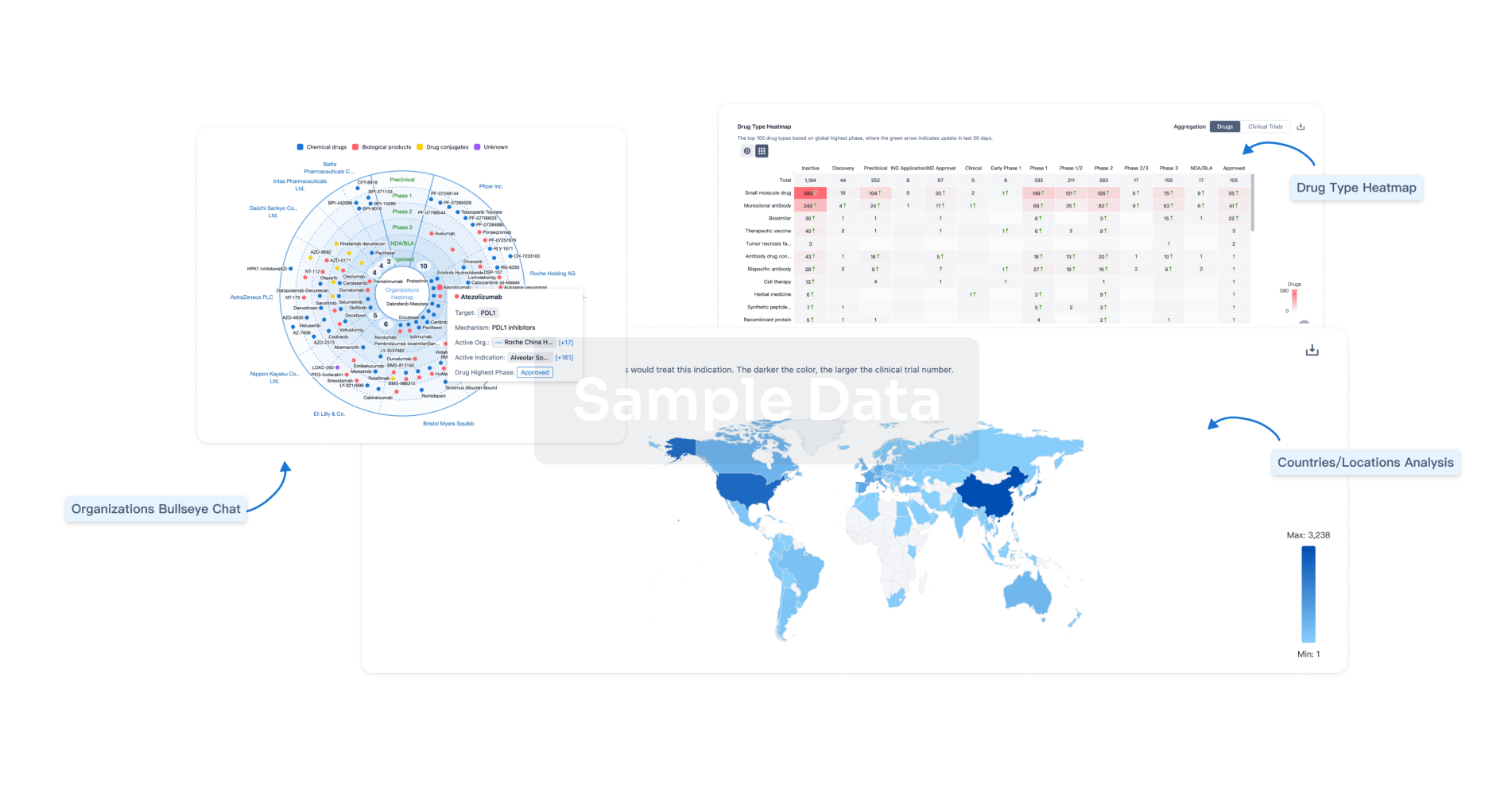Request Demo
Last update 08 May 2025
RET mutation Solid Tumors
Last update 08 May 2025
Basic Info
Synonyms- |
Introduction- |
Related
5
Drugs associated with RET mutation Solid TumorsTarget |
Mechanism RET inhibitors |
Active Org. |
Originator Org. |
Active Indication |
Inactive Indication |
Drug Highest PhaseApproved |
First Approval Ctry. / Loc. United States |
First Approval Date04 Sep 2020 |
Target |
Mechanism RET inhibitors |
Active Org. |
Originator Org. |
Active Indication |
Inactive Indication |
Drug Highest PhaseApproved |
First Approval Ctry. / Loc. United States |
First Approval Date08 May 2020 |
Target |
Mechanism RET modulators |
Active Org. |
Originator Org. |
Active Indication |
Inactive Indication- |
Drug Highest PhasePhase 1/2 |
First Approval Ctry. / Loc.- |
First Approval Date20 Jan 1800 |
9
Clinical Trials associated with RET mutation Solid TumorsCTR20223304
一项评价选择性RET抑制剂TY-1091胶囊在晚期实体瘤患者中安全性、耐受性、药代动力学及有效性的I/II期临床研究
[Translation] A Phase I/II clinical study evaluating the safety, tolerability, pharmacokinetics and efficacy of the selective RET inhibitor TY-1091 capsule in patients with advanced solid tumors
主要目的:剂量递增阶段:(1)评价不同剂量下TY-1091胶囊在晚期实体瘤患者中的安全性和耐受性;(2)确定MTD和RP2D。扩展阶段:评估TY-1091治疗晚期实体瘤患者的疗效。次要目的:剂量递增阶段:(1)考察TY-1091在RET阳性晚期实体瘤患者中的药代动力学特征;(2)评估TY-1091的初步抗肿瘤活性。扩展阶段:(1)评价TY-1091在RET阳性晚期实体瘤患者中的安全性;(2)考察TY-1091的药代动力学特征。
[Translation]
Primary objectives: Dose escalation phase: (1) Evaluate the safety and tolerability of TY-1091 capsules at different doses in patients with advanced solid tumors; (2) Determine the MTD and RP2D. Extension phase: Evaluate the efficacy of TY-1091 in the treatment of patients with advanced solid tumors. Secondary objectives: Dose escalation phase: (1) Investigate the pharmacokinetic characteristics of TY-1091 in patients with RET-positive advanced solid tumors; (2) Evaluate the preliminary anti-tumor activity of TY-1091. Extension phase: (1) Evaluate the safety of TY-1091 in patients with RET-positive advanced solid tumors; (2) Investigate the pharmacokinetic characteristics of TY-1091.
Start Date17 Apr 2023 |
Sponsor / Collaborator |
NCT05653869
A Phase 1 Study to Investigate the Safety, Tolerability, Pharmacokinetics, and Preliminary Efficacy of APS03118 in Adult Patients With Unresectable Locally Advanced or Metastatic Solid Tumors Harboring RET Mutations or Fusions
This is a Phase 1, open-label, first-in-human (FIH) study designed to evaluate the safety, tolerability, pharmacokinetics (PK) and preliminary antineoplastic activity of APS03118 administered orally in participants with RET-altered solid tumors.
Start Date06 Feb 2023 |
Sponsor / Collaborator |
CTR20222441
一项在携带RET突变或融合的不可切除、局部晚期或转移性实体瘤成人患者中研究APS03118的安全性、耐受性、药代动力学和初步疗效的I期研究
[Translation] A Phase I study investigating the safety, tolerability, pharmacokinetics, and preliminary efficacy of APS03118 in adult patients with unresectable, locally advanced, or metastatic solid tumors harboring RET mutations or fusions
主要目的:
确定APS03118的最大耐受剂量(MTD)和/或II期推荐剂量(RP2D)
评价APS03118的安全性和耐受性 次要目的:
评价APS03118的药代动力学(PK)特征
根据第1.1版实体瘤疗效评价标准(RECIST)评估APS03118的初步抗肿瘤疗效
[Translation]
Primary objectives:
Determine the maximum tolerated dose (MTD) and/or recommended phase II dose (RP2D) of APS03118
Evaluate the safety and tolerability of APS03118 Secondary objectives:
Evaluate the pharmacokinetic (PK) characteristics of APS03118
Assess the preliminary anti-tumor efficacy of APS03118 according to RECIST version 1.1
Start Date17 Nov 2022 |
Sponsor / Collaborator |
100 Clinical Results associated with RET mutation Solid Tumors
Login to view more data
100 Translational Medicine associated with RET mutation Solid Tumors
Login to view more data
0 Patents (Medical) associated with RET mutation Solid Tumors
Login to view more data
48
Literatures (Medical) associated with RET mutation Solid Tumors01 Mar 2025·JTO Clinical and Research Reports
Mucocutaneous Adverse Events in Patients With Cancer Treated with the Highly Selective RET Kinase Inhibitor Selpercatinib (LOXO-292)
Article
Author: Moy, Andrea P ; Reingold, Rachel E ; Dranitsaris, George ; Harada, Guilherme ; Lacouture, Mario E ; Francis, Jasmine H ; Parisi, Rose ; Kaplanis, Lauren A ; Canestraro, Julia ; Drilon, Alexander ; Liu, Dazhi ; Lester, Julia A
18 Feb 2025·Endocrine Oncology
Overview of management and therapeutic advances in medullary thyroid cancer
Review
Author: Jara, Mark A ; Castroneves, Luciana Audi
18 Feb 2025·The Journal of Clinical Endocrinology & Metabolism
Clinical Activity of Selpercatinib in RET-mutant Pheochromocytoma
Article
Author: Wright, Jennifer ; Xu, Xiaojian ; Konda, Bhavana ; Massarelli, Erminia ; Deschler-Baier, Barbara ; Wirth, Lori J ; Hu, Mimi I ; Clifton-Bligh, Roderick J
27
News (Medical) associated with RET mutation Solid Tumors12 Jun 2024
The FDA on Wednesday granted full approval to Eli Lilly’s selective RET kinase inhibitor Retevmo (selpercatinib) to treat adults and paediatric patients two years and older who have advanced or metastatic RET fusion-positive thyroid cancer, are radioactive iodine-refractory, and require systemic therapy. The clearance follows a 2020 accelerated approval in the indication for patients 12 years and older, as well as one for paediatric patients awarded by the US regulator in May.Last month’s accelerated approval also covered RET fusion-positive locally advanced or metastatic solid tumours and medullary thyroid cancer.Supporting dataThe accelerated approval was converted to full approval based on data from the Phase I/II LIBRETTO-001 study, which enrolled patients 12 years and older. Retevmo achieved an overall response rate (ORR) of 85% in 41 previously-treated thyroid cancer patients, and an ORR of 96% in 24 participants who were systemic-therapy naïve.The former group of patients also had a median duration of response (DOR) of 26.7 months, while DOR has not yet been achieved in the latter cohort.Supporting data for the paediatric approval was derived from 10 young adults and children with RET-altered solid tumours who participated in the Phase I/II LIBRETTO-121 study. Retevmo led to an ORR of 60%, and 83% of participants achieved a DOR of one year or longer.
Drug ApprovalAccelerated ApprovalClinical Result
12 Jun 2024
On June 12, 2024, the Food and Drug Administration granted traditional approval to selpercatinib (Retevmo, Eli Lilly and Company) for adult and pediatric patients 2 years of age and older with advanced or metastatic RET fusion-positive thyroid cancer who require systemic therapy and who are radioactive iodine-refractory (if radioactive iodine is appropriate).
Selpercatinib received accelerated approval for this indication for patients 12 years of age and older in 2020.
Full prescribing information for Retevmo will be posted on Drugs@FDA.
Efficacy and Safety
Efficacy was evaluated in LIBRETTO-001 (NCT03157128), a multicenter, open-label, muti-cohort clinical trial in 65 patients with RET fusion-positive thyroid cancer who were radioactive iodine (RAI)-refractory (if RAI was an appropriate treatment option) and were systemic therapy naïve and patients who were previously treated, in separate cohorts.
The major efficacy outcome measures were overall response rate (ORR) and duration of response (DOR). The ORR was 85% (95% CI: 71%, 94%) in the 41 previously treated patients and 96% (95% CI: 79%, 100%) in the 24 systemic therapy naïve patients. Median DOR was 26.7 months (95% CI: 12.1, not evaluable [NE]) in the previously treated patients and NE (95% CI: 42.8, NE) in the systemic therapy naïve patients.
Supportive evidence included ORR and DOR data from 10 pediatric and young adult patients with RET fusion-positive thyroid cancer treated in Study LIBRETTO-121 (J2G-OX-JZJJ; NCT03899792), an international, single-arm, multi-cohort clinical trial of selpercatinib in pediatric and young adult patients with advanced RET-altered solid tumors. The ORR was 60% (95% CI: 26%, 88%), and 83% had an observed duration of response ≥ 12 months.
The most common adverse reactions (≥25%) were edema, diarrhea, fatigue, dry mouth, hypertension, abdominal pain, constipation, rash, nausea, and headache. The most common Grade 3 or 4 laboratory abnormalities (≥5%) were decreased lymphocytes, increased alanine aminotransferase (ALT), increased aspartate aminotransferase (AST), decreased sodium, and decreased calcium.
The recommended selpercatinib dose for pediatric patients 2 to less than 12 years of age is based on body surface area. It is based on weight for patients 12 years of age and older. See the prescribing information for specific dosing information.
Expedited Programs
This review used the Assessment Aid, a voluntary submission from the applicant to facilitate the FDA’s assessment.
This application was granted breakthrough designation and orphan drug designation. FDA expedited programs are described in the Guidance for Industry: Expedited Programs for Serious Conditions-Drugs and Biologics.
Healthcare professionals should report all serious adverse events suspected to be associated with the use of any medicine and device to FDA’s MedWatch Reporting System or by calling 1-800-FDA-1088.
For assistance with single-patient INDs for investigational oncology products, healthcare professionals may contact OCE’s Project Facilitate at 240-402-0004 or email OncProjectFacilitate@fda.hhs.gov.
Follow the Oncology Center of Excellence on X (formerly Twitter) @FDAOncologyExternal Link Disclaimer.
Orphan DrugDrug ApprovalClinical ResultAccelerated ApprovalBreakthrough Therapy
29 May 2024
The FDA on Wednesday granted Eli Lilly’s selective RET kinase inhibitor Retevmo (selpercatinib) accelerated approval to treat children two years and older with certain RET-mutated thyroid and solid tumours. According to the US regulator, it’s the first targeted cancer therapy for paediatric patients younger than 12 with RET alterations.Specifically, Retevmo was cleared for advanced or metastatic medullary thyroid cancer with a RET mutation; advanced or metastatic thyroid cancer with a RET gene fusion in patients who are radioactive iodine-refractory; and locally advanced or metastatic solid tumours with a RET gene fusion in patients who have progressed on a prior systemic therapy. The RET inhibitor already holds accelerated approval for the thyroid cancer indications in adults and paediatric patients older than 12, as well as the solid tumour indication in adults.Supporting dataThe new paediatric approval was based on results of the Phase I/II LIBRETTO-121 study in 25 patients ages 2 to 20 with locally advanced or metastatic RET-activated solid tumours non-responsive to available therapies.Retevmo led to a confirmed overall response rate (ORR) of 48%. Additionally, the median duration of response (DOR) was not reached, with 92% of responders still seeing a treatment effect at 12 months.The most common adverse reactions seen in more than a quarter of patients were musculoskeletal pain, diarrhoea, headache, nausea, vomiting and fatigue, among others.Lily gained Retevmo through its $8-billion acquisition of Loxo Oncology in 2019.
Clinical ResultDrug ApprovalAcquisitionAccelerated Approval
Analysis
Perform a panoramic analysis of this field.
login
or

AI Agents Built for Biopharma Breakthroughs
Accelerate discovery. Empower decisions. Transform outcomes.
Get started for free today!
Accelerate Strategic R&D decision making with Synapse, PatSnap’s AI-powered Connected Innovation Intelligence Platform Built for Life Sciences Professionals.
Start your data trial now!
Synapse data is also accessible to external entities via APIs or data packages. Empower better decisions with the latest in pharmaceutical intelligence.
Bio
Bio Sequences Search & Analysis
Sign up for free
Chemical
Chemical Structures Search & Analysis
Sign up for free




